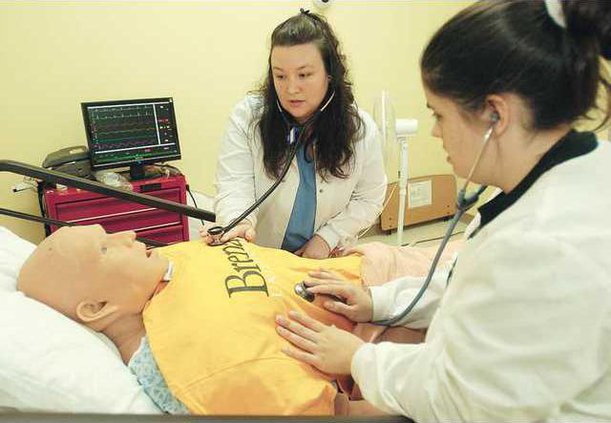Video: Watch Brenau nursing students practice on iStan, the simulated patient.
Until recently, the only way for a doctor or nurse to learn a new procedure was to practice their skills on an actual patient.
But there are obvious problems with using humans as "guinea pigs," so technology has come to the rescue. Increasingly, nursing and medical schools are using sophisticated simulators to teach students.
These models are nothing like the "dummies" that are sometimes used to teach CPR. The computerized simulators can be programmed to mimic body functions such as heartbeat and respiration and to replicate symptoms of illness.
Since August, Brenau University’s nursing school has been using an adult patient simulator called "iStan" to train student nurses.
And Northeast Georgia Medical Center’s new Women & Children’s Pavilion soon will be getting "SimNewB doll," designed to look and move like a newborn baby. It will be used to train staff in the neonatal intensive care unit and the obstetrics department.
"It has the most realistic anatomy of any resuscitation doll," said Shelley Worden, neonatal nurse practitioner.
Every nurse who works with newborns at the medical center is required to take a periodic refresher course on how to revive a baby that has stopped breathing. Resuscitation occasionally is needed when a baby takes a turn for the worse, and it’s also used in the delivery room when a baby emerges from the womb and fails to start breathing.
"This is the first time we’ve had a (simulator) baby realistic enough that you could do intubation on it," said Worden.
Intubation is a procedure for inserting a breathing tube down a patient’s throat. It takes a lot of skill to intubate a premature infant because the airway is so tiny.
Dr. Jim Holcomb, chief neonatologist at the medical center, said the simulator will allow nurses to practice those skills safely.
"It’s going to be a great tool for training staff," he said. "We can program it to do almost anything you would commonly encounter. You can simulate situations such as a collapsed lung, and (the system) has lifelike clinical feedback built into it."
For example, if programmed to show that the baby isn’t getting enough oxygen, the doll’s lips will turn blue. As nurses try various measures to restore breathing, they can watch a graphic display on the monitor to see whether the baby’s oxygen saturation is improving.
"Before simulators, you just had to use your imagination. It was all just pretend," said Worden. "You had no capability of listening for a heartbeat or breath sounds."
Worden said the simulator costs about $33,000 and was made possible by donations from the Medical Center Foundation and from Dare to Share, a nonprofit that helps special-needs children.
The simulator used at Brenau costs more than $100,000, but it’s a far more complicated machine than the newborn doll.
Brenau nursing professor Cathy Dyches said iStan has an astonishing array of capabilities.
"He can talk, blink, gag and cry," she said. "His forehead can sweat. His fingertips can turn blue (from lack of oxygen). He can have a seizure or go into cardiac arrest. He can urinate, and he can bleed. We can make the blood be oozing, or we can have it be like arterial blood squirting out."
Dyches said the only drawback is that iStan can’t move his mouth. He has prerecorded phrases that he can say, such as "Ouch" or "My stomach hurts." But there’s also a microphone so the instructor can be iStan’s voice.
"He weighs 180 pounds, just like a live person, so students can feel what it’s like to turn and move him," said Dyches.
Each time he takes a breath, iStan’s chest rises and falls. Thursday afternoon, first-year nursing student Rachel Blasingame practiced using a stethoscope to check iStan’s breathing.
"I can listen to his lungs and hear congestion and a friction rub (a grating sound from the surface of the lungs)," she said. "That’s helpful for me because the sounds can be difficult to learn."
Dyches said the students love working with iStan.
"They treat him as if he’s a real person," she said. "They get upset when he starts going bad."
Thursday, Dyches programmed iStan to "go bad" so the students could learn to shock him back to life with a defibrillator.
She said sometimes, to make the situation even more realistic, they’ll have people in the room pretending to be distraught family members. This helps students learn to concentrate on their work despite distractions.
Since August, about 170 of the school’s 238 undergraduate students have trained in the simulation lab. Keeta Wilborn, chairwoman of the nursing department, said iStan has been well worth the investment.
"We do have small models that we use to teach basic skills, such as giving injections and inserting IVs, but it’s not like working with a real patient," she said.
"And there’s a shortage of clinical placements (in hospitals) for student training, so this is a great addition to what students can do in clinical practice."
Eventually, of course, the students will have to work with real people.
"When that time comes, they will have more confidence in their skills because of the simulator," said Wilborn. "I don’t see it taking the place of working with live human beings, but I think it’s a real enhancement to what we do."
She said iStan also allows students to train for situations that they might not be lucky enough to encounter during their clinical rotations.
"We can simulate some things they may rarely see in routine practice, such as anaphylactic shock," she said.
Wilborn said iStan has been such a success that Brenau is considering buying simulators that represent a greater diversity of patients.
"We’ve talked about writing some grants to maybe get a pediatric simulator, or even a birthing one," she said.

